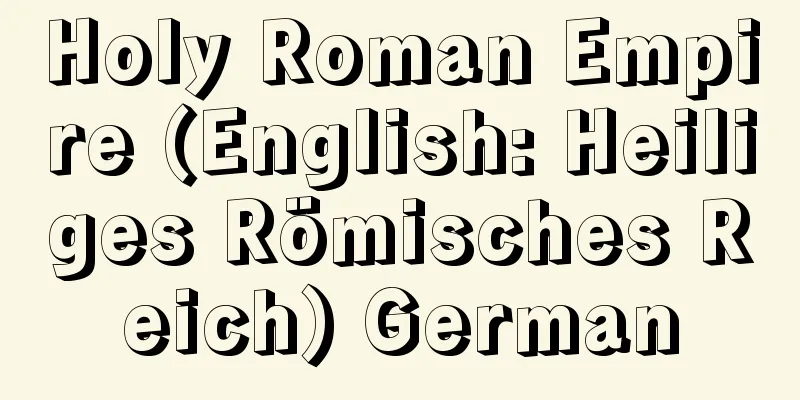Holy Roman Empire (English: Heiliges Römisches Reich) German

|
The name of the German state that began with Otto I's coronation as Holy Roman Emperor in 962 and lasted until 1806. [Shosuke Hirajo] nameThe official name of the Holy Roman Empire is Heiliges Römisches Reich Deutscher Nation (German) or Sacrum Romanum Imperium Nationis Germanicae (Latin), but this empire was not originally called that. The Carolingian Empire, the precursor of the empire, did not have a special name, and was simply called the "empire" (Imperium) even during the time of Otto I. The adjective "Roman" was added during the time of Otto II (reigned 967-983), and became common especially during the time of the next emperor, Otto III (reigned 996-1002), who set the restoration of the Roman Empire as a political goal. The adjective "holy" was added during the time of Frederick I (Redbeard) of the Staufen dynasty. Originally, the Holy Roman Empire was a kind of divine government supported by two pillars, the imperial power and the papacy. However, as a result of the Investiture Controversy, the separation and conflict between the papacy (sacred power) and the imperial power (secular power) came to the surface, and the imperial power became increasingly secular. The situation did not take the simple form of a distinction between sacred and secular power, but the imperial power and the papacy both maintained that they had both sacred and secular aspects. The imperial side maintained that the imperial title was not bestowed by the pope, but was directly decided by the grace of God and the election of the princes, and contrasted the "holy church" (Sancta Ecclesia) with the "sacred empire" (Sacrum Imperium). As a result, the term "Holy Roman Empire" first appeared during the reign of Wilhelm von Holland (reigned 1247-56), the emperor of the Interregnum. At the end of the Middle Ages, emperors lost the ability to maintain control over Italy, and the practice of being elected king, invading Rome, and then being crowned emperor by the Pope ended with Frederick III in 1452. The territory of the Holy Roman Empire was limited to Germany, so from the end of the 15th century the qualifier "of the German people" was added to the name. [Shosuke Hirajo] Empire in TransitionThe historical precursor of the Holy Roman Empire is the so-called Carolingian Empire, which began with the coronation of Charlemagne in 800, but this empire was also considered a revival of the Western Roman Empire, which had collapsed in 476. After the death of Louis I the Pious, the Carolingian Empire was divided into three parts, with Middle Francia and the Imperial throne being inherited by his eldest son Lothar, and East Francia and West Francia being inherited by Louis and Charles, respectively. East Francia developed into the Kingdom of Germany, and West Francia into the Kingdom of France, but after Lothar's death, Middle Francia was further divided into Lorraine, Burgundy, and Italy, and the Carolingian royal line was eventually cut off. Lorraine was divided into East and West Francia by the Treaty of Mersen (870) and the Treaty of Ribemont (880), but in Burgundy and Italy, local powerful families each claimed to be kings and continued to fight and quarrel. The second Saxon king, Otto I, conquered and annexed Burgundy and Italy, and became Holy Roman Emperor by acquiring the tradition of imperial power that had remained in those lands. Just as Charlemagne was crowned by Pope Leo III, Otto I made two campaigns in Italy and was crowned as emperor by Pope John XII in 962. From then on, it became a tradition for successive German kings to make campaigns in Rome after ascending to the throne and to be crowned as emperor by the Pope. The emperor had almost no independent authority and was merely a nominal title, but as the protector of the papacy, he ideally had a kind of superiority over the Christian world in Western Europe. This superiority was maintained through the three dynasties of Saxony, Salier, and Staufen, although there were some fluctuations, but at the same time, it also contained an opportunity for the conflict between church and secular power that would later become apparent. The Kingdom of Germany during the Saxon period was a composite of several tribal grand duchies, such as Swabia, Saxony, Bavaria, and Franconia, but as the power of the tribal grand duchies grew and their ties with the local tribes strengthened, there was a constant danger of the kingdom splitting apart. In order to counter this, Otto I adopted the so-called "Imperial Church Policy," which sought to bolster the unity of the nation by linking it with the church power within the country. This policy granted land to high-ranking clergy such as archbishops, bishops, and imperial abbots as donations or fiefs, and gave them various privileges and protection, while at the same time placing them in key positions in domestic governance. This policy was inherited by the Saxon emperors and the early Salier dynasty emperors, and was quite successful. Henry III (reigned 1039-56) in particular took the lead in the church reform movement that was gaining momentum at the time, and helped reform the papacy, contributing greatly to the establishment of the authority of the papacy and realizing the height of the Holy Roman Empire's prosperity. However, church reform and the strengthening of papacy were a double-edged sword for the imperial church policy. This policy was premised on the emperor's right to appoint clergy, and when high-ranking clergy were appointed archbishops, bishops, and imperial abbots, they became vassals of the emperor and were obligated to serve the emperor as vassals. This was seen as a form of simony, which was one of the targets of the church reform, and ultimately led to the denial of the secular ordination of clergy. In particular, the conflict between Pope Gregory VII, who sought to establish the supremacy of the Pope, and Henry IV, who ignored the Pope's warnings and went ahead with the investiture of the Bishop of Milan, was linked to the political situation in Germany, where the emperor was strengthening royal power and there were conflicts with domestic princes who opposed this, and developed into a nationwide civil war, the so-called Investiture Controversy. The civil war was put to an end by the Concordat of Worms (1122), but in the meantime feudalization in Germany progressed rapidly, with secular and religious princes setting out on the path to establishing their own territories and establishing control over them. In response to this, Frederick I of the Staufen dynasty worked to establish his own territories, mainly in southwestern Germany (Imperial Territorial Policy), and he came to take on the characteristics of both emperor and lord of a territory, which would have a major impact on the fate of the Empire in the late Middle Ages, during the Springender Wahl period, when the imperial throne changed hands frequently through elections. Frederick I was successful in overthrowing the most powerful of the princes, Henry the Lion (1139-80 Duke of Saxony and 1156-80 Duke of Bavaria), but he forced the princes to accept the principle of compulsory granting of fiefs (confiscated fiefs had to be re-granted within one year and one day), and the Holy Roman Empire was decisively transformed into a feudal state. His grandson, Frederick II, again made significant concessions to the princes within his own country, further advancing the path to establishing control over the states. After the end of the Staufen dynasty and the Great Interregnum, Rudolf I of the Habsburg family (reigned 1273-91) was elected emperor, but the principle of elective monarchy became dominant in the empire thereafter, and the throne changed hands between the Habsburgs, the Luxembourg, the Wittelsbachs, and others depending on the interests of the electors (the period of skip elections), and the emperors began to prioritize their own interests as territorial monarchs over the interests of the empire as a whole, which weakened the empire. At the end of the Middle Ages, the throne was fixed in the hands of the Habsburgs, and continued until the fall of the empire, but the Treaty of Westphalia, which ended the Thirty Years' War (1618-48), granted territorial monarchs independence almost equivalent to the sovereignty of independent states, and the division of the empire into territorial states was decisive, and the imperial power in the early modern period became purely nominal, with the Habsburgs only effectively ruling parts of their territories of Austria and southwestern Germany. In 1806, when the 16 southern German states that were members of the Confederation of the Rhine, formed under the protection of Napoleon I, declared their secession from the Holy Roman Empire, the last Emperor, Francis II, declined the imperial crown, bringing an end to the Empire's approximately 840-year history. [Shosuke Hirajo] Imperial StructureThe area of the empire changed over time, but its core consisted of Germany, Burgundy, and Italy (Central and northern Italy). It also exercised some sovereignty over Denmark, Poland, Bohemia, Moravia, and for a time Hungary, and during the Staufen period also included Sicily. Since the emperor was also the German king, the principle of the king's election was also the principle of the emperor's election. It was customary for the king to make an expedition to Rome after ascending to the throne and receive the imperial crown from the Pope, but the decision of the Council of Electors of Lenze and the Council of the Empire of Frankfurt in 1338 established the principle that the German king elected by the Council of Electors was also the Holy Roman Emperor immediately without waiting for the Pope's crowning, and the practice of the expedition to Rome itself was no longer practiced after Maximilian I at the end of the Middle Ages. The German monarchy is a combination of the two principles of elective monarchy and hereditary monarchy, and as long as the dynasty was stable, the principle of hereditary monarchy prevailed in practice even if elections were held formally, but when the dynasty was broken, the principle of elective monarchy came to the forefront. Since the principle of election was unanimous, if the electors were unable to coordinate their opinions in advance, it was common for each party to hold an election meeting in a different place and elect a rival emperor (double election). To correct this deficiency, Charles IV issued the Golden Bull (1356), which introduced the principle of majority rule, limited the number of electors to seven, and fixed the electoral procedures. The seven electors were the archbishops of Mainz, Trier and Cologne, the Counts of the Rhine, the Kings of Bohemia, the Grand Dukes of Saxony and the Margraves of Brandenburg, although their number fluctuated from the 17th century onwards. The medieval German state was essentially a feudal state, and the emperor's rule over the country was carried out through feudal lord-vassal relationships between the emperor and his vassals, so there was no local administrative organization worth mentioning except in the territories directly under the empire. The central administrative structure was also mainly documentary, and was dominated by the Reichskanzlei, an Imperial Secretariat appointed by clergy. Its highest official was the Chief Secretary of the Empire, Reichserzkanzen, appointed by the Archbishop of Mainz. Its authority was limited to Germany, and separate Chief Secretaries were appointed for Italy and Burgundy, the Archbishop of Cologne for the former and the Archbishop of Trier for the latter. Other central administrative structures included the Hofgericht, the Imperial Court, which was responsible for handling litigation, the Hofrat, and the Reichstag, which developed from it. The emperor's vassals included secular princes with titles such as grand duke, margrave, and count, high-ranking clergy such as archbishops, bishops, and imperial abbots, and untitled Freiherr. As a result of the establishment of the imperial prince status and the strengthening of territorial control during the Staufen dynasty, many counts and Freiherr became vassals to the emperor. In territories directly under the empire, imperial magistrates (Reichsvogt) were placed as the emperor's governors. As imperial cities were established, imperial magistrates were divided into local magistrates (Landvogt) and city magistrates (Stadtvogt). From around the end of the Middle Ages, it became customary for imperial cities (representatives) to attend the Imperial Diet, and the Treaty of Westphalia (1648) confirmed the eligibility of imperial cities to attend the Imperial Diet. [Shosuke Hirajo] "The Development of the Western Medieval World" by Konno Kunio (1979, Iwanami Shoten)" ▽ "History at a Turning Point" by G. Baraclough, translated by Maekawa Teijiro and Kaneiwa Masao (1964, Shakaishisosha)" ▽ "Theocracy" by M. Pacaud, translated by Sakaguchi Kokichi and Sumi Seiichi (1985, Sobunsha)" ▽ "The Holy Roman Empire" by Heijo Shosuke (included in "New Edition of German History" 1977, Yamakawa Publishing)" [References] | | |©Shogakukan "> The transformation of the Holy Roman Empire (Hohenschwangau) ©Shogakukan "> Changes in the territory of the Holy Roman Empire (The Thirty Years' War) Source: Shogakukan Encyclopedia Nipponica About Encyclopedia Nipponica Information | Legend |
|
962年のオットー1世の神聖ローマ皇帝戴冠(たいかん)に始まり、1806年まで続いたドイツ国家の名称。 [平城照介] 名称神聖ローマ帝国の正式の名称は「ドイツ民族の神聖ローマ帝国」Heiliges Römisches Reich Deutscher Nation(ドイツ語)、Sacrum Romanum Imperium Nationis Germanicae(ラテン語)であるが、この帝国が最初からそうよばれていたわけではない。帝国の先駆形態であるカロリング帝国はもとより、オットー1世の時代でも特別の名称はなく、単に「帝国」Imperiumとよばれていた。「ローマ」という形容詞が加わったのはオットー2世(在位967~983)の時代からで、とりわけ、ローマ帝国の復興を政治目的に掲げた次のオットー3世(在位996~1002)の時代に一般化する。さらに「神聖」なる形容詞が加わるのは、シュタウフェン朝のフリードリヒ1世(赤髯(あかひげ)王)の時代である。もともと神聖ローマ帝国は皇帝権と教皇権の2本の柱に支えられた一種の神聖政体であるが、聖職叙任権闘争の結果、教皇権=聖権と皇帝権=俗権の分離・対立が表面化し、皇帝権の世俗化が著しくなり、事態は聖・俗両権の分化という単純な形をとらず、皇帝権も教皇権もともに聖・俗両面を有するという主張を譲らなかった。皇帝側は、皇帝位は教皇によって授けられるものでなく、直接に神の恩寵(おんちょう)と諸侯の選挙によって決定されると主張し、「聖なる教会」Sancta Ecclesiaに「神聖な帝国」Sacrum Imperiumを対置した。その結果、大空位時代の皇帝、ウィルヘルム・フォン・ホラントWilhelm von Holland(在位1247~56)の時代に、初めて「神聖ローマ帝国」という名称が出現してくる。中世末、皇帝はイタリア支配を維持してゆく実力を失い、国王に選挙されたのち、ローマ遠征を行って教皇より皇帝として戴冠する慣行も、1452年のフリードリヒ3世を最後に後を絶った。神聖ローマ帝国の版図はドイツに限られたわけで、それに対応して、15世紀末より、「ドイツ民族の」という限定詞が付加されることとなった。 [平城照介] 帝国の変遷神聖ローマ帝国の歴史的先蹤(せんしょう)は、800年のカール(大帝)の戴冠に始まる、いわゆるカロリング帝国であるが、この帝国もまた、476年に滅亡した西ローマ帝国の復活とみなされるものであった。ルートウィヒ(ルイ)1世(敬虔(けいけん)王)の死後、カロリング帝国は三分され、中部フランクと皇帝位は長男のロタールが、東フランクと西フランクはそれぞれルートウィヒとカールが継承し、東フランクはドイツ王国へ、西フランクはフランス王国へと発展するわけであるが、中部フランクはロタールの死後さらに、ロートリンゲン、ブルグント、イタリアに分割され、やがてカロリング家の王統も断絶した。ロートリンゲンはメルセン条約(870)、リベモン条約(880)により東西フランクに分割されたが、ブルグント、イタリアでは、在地の大豪族たちがそれぞれ王を自称し、対立・抗争を続けていた。 ザクセン朝第2代の国王オットー1世は、このブルグントとイタリアを征服、併合し、この地に残っていた皇帝権の伝統を手に入れることにより神聖ローマ皇帝となるわけであるが、ちょうどカール大帝がローマ教皇レオ3世の手により戴冠されたように、2回にわたるイタリア遠征を行い、962年、教皇ヨハネス12世の手により皇帝として戴冠された。以後歴代ドイツ国王は、即位後ローマ遠征を行い、教皇から皇帝として加冠されることが伝統となった。皇帝独自の権限というようなものはほとんどなく、名目的称号にすぎないが、教皇権の保護者であるという機能により、理念的には西欧キリスト教世界に一種の優越性を有したわけである。この優越性は、ザクセン、ザリエル、シュタウフェン3王朝を通じて若干の変動はあったとはいえ維持されたといえるが、同時に、のちに顕在化する教権と俗権との対立の契機をも含んでいた。 ザクセン朝時代のドイツ王国は、シュワーベン、ザクセン、バイエルン、フランケンなど、いくつかの部族大公領の合成体であったが、これは、部族大公の権力が強まり、在地の部族民との結合が強固になると、絶えず王国を分裂に導く危険を秘めていた。オットー1世はこれに対抗すべく、国家統一の支柱を、国内の教会勢力との結び付きに求める、いわゆる「帝国教会政策」なるものを採用した。大司教、司教、帝国修道院長などの高級聖職者に所領を寄進ないし封土として与え、種々の特権と保護を与えると同時に、彼らを国内統治上の枢要の地位につけるという政策である。この政策はザクセン朝の諸帝および初期ザリエル朝の皇帝によって継承され、かなりの成功を収めた。とりわけハインリヒ3世(在位1039~56)は、当時盛んになりつつあった教会改革運動の主導権を握り、教皇庁の改革をも助けて教皇権の権威の確立に貢献するところが大きく、神聖ローマ帝国の最盛期を実現した。だが、教会改革と教皇権の強化は、帝国教会政策にとっていわば両刃の剣であった。この政策は皇帝の聖職者に対する叙任権を前提としており、高位聖職者は大司教、司教、帝国修道院長に叙任されると同時に皇帝の封臣となり、皇帝に対し封臣としての奉仕の義務を負うが、これが教会改革の一つの攻撃目標であった聖職売買の一種とみなされ、ひいては俗権による聖職者叙任そのものまで否定される結果を生んだからである。とくに、教皇の至上権の確立を意図した教皇グレゴリウス7世と、教皇の警告を無視してミラノ司教の叙任を強行したハインリヒ4世との争いは、皇帝の王権強化政策と、それに反発する国内諸侯との対立というドイツ国内の政治状況と結び付いて、全国的内乱、いわゆる聖職叙任権闘争にまで発展したのである。 内乱はウォルムス協約(1122)によって収束したが、その間にドイツの封建化は急速に進み、聖俗の諸侯はそれぞれの領邦の樹立と領邦支配権の確立への道を踏み出す。これに対抗すべく、シュタウフェン朝のフリードリヒ1世は、西南ドイツを中心に皇帝自身も自己の領国の形成に努め(帝国領国政策)、皇帝であると同時に、一個の領邦君主でもあるという性格を帯びるに至り、中世後期、帝位が選挙により転々とするいわゆる「跳躍選挙」Springender Wahlの時代には帝国の運命に重大な影響を与えることになる。フリードリヒ1世は、諸侯中最大のハインリヒ獅子(しし)公Heinrich der Löwe(ザクセン公在位1139~80、バイエルン公在位1156~80)を失脚させるのにいちおう成功したが、諸侯から授封強制の原則(没収した封は1年と1日以内に再授封しなければならない)を承認させられ、神聖ローマ帝国は決定的に封建国家に転化した。孫フリードリヒ2世も再度にわたり国内諸侯に大幅に譲歩し、諸邦支配権確立の道をいっそう進めた。 シュタウフェン朝の断絶、大空位時代を経て、ハプスブルク家のルードルフ1世(在位1273~91)が皇帝に選挙されるが、以後帝国では選挙王制の原理が支配的となり、帝位は選帝諸侯の利害によって、ハプスブルク家、ルクセンブルク家、ウィッテルスバハ家などの間を転々とし(跳躍選挙の時代)、皇帝は帝国全体の利害よりも、一個の領邦君主として自家の利害を重視するようになり、帝国の弱体化を招いた。中世末、帝位はハプスブルク家に固定し、帝国の滅亡まで続くが、三十年戦争(1618~48)を終結させたウェストファリア条約により、領邦君主にほぼ独立国家の国家主権に近い自立性が承認された結果、帝国の領邦国家への分裂は決定的となり、近世の皇帝権はまったく名目だけと化し、ハプスブルク家は家領のオーストリアと西南ドイツの一部のみを実質的に支配するにすぎない状態となった。1806年、ナポレオン1世の保護下に結成されたライン同盟加盟の南ドイツ16領邦が神聖ローマ帝国からの脱退を宣言するに及んで、最後の皇帝フランツ2世は帝冠を辞退し、ここに帝国はおよそ840年の歴史に終止符を打った。 [平城照介] 帝国の機構帝国の領域は時代によって変化したが、中核を形成したのはドイツ、ブルグント、イタリア(中部以北)である。デンマーク、ポーランド、ボヘミア、モラビア、また一時はハンガリーにもある程度の主権を行使し、シュタウフェン朝時代にはシチリア島も帝国に含まれた。 皇帝は、ドイツ国王が兼ねたのであるから、国王選出の原則が同時に皇帝選出の原則でもあった。国王は即位後ローマ遠征を行い、教皇から帝冠を受けるのが慣行であったが、1338年のレンゼ選帝侯会議およびフランクフルト帝国会議の決定により、選帝侯会議によって選出されたドイツ国王は、教皇の加冠を待たず、ただちに神聖ローマ皇帝でもあるという原則が確立し、ローマ遠征の慣行自体も中世末のマクシミリアン1世以後行われなくなった。ドイツ王制は選挙王制と世襲王制との二つの原理が結合したもので、王朝が安定している限り、形式的に選挙が行われても、実質上は世襲制の原理が支配的であったが、王朝が断絶すると、選挙制の原理が前面に出てくる。選挙は全会一致が原則であったので、事前に選挙人の意見の調整に成功しなかった場合には、それぞれが別な場所で選挙会議を開き対立皇帝を選出する(二重選挙)という事態がしばしば生じた。この欠陥を是正するため、カール4世は金印勅書を発布し(1356)、多数決原理の導入を図るとともに、選帝侯の数を7人に限定し、選挙手続も確定した。 7人の選帝侯は、マインツ、トリール、ケルンの大司教、ライン宮廷伯、ベーメン王、ザクセン大公、ブランデンブルク辺境伯であるが、17世紀以降その数に増減があった。 中世のドイツ国家は基本的に封建国家であり、皇帝の全国統治は皇帝と封臣間の封建的主従関係を介して行われたので、帝国直轄領を除き、いうに足る地方行政組織は存在しない。中央の行政機構も、その主要部分は文書行政であったので、聖職者が任ぜられる帝国書記局Reichskanzleiが主体であった。その最高官職は帝国書記官長Reichserzkanzenで、マインツ大司教が任命された。その職権はドイツに限られ、イタリアおよびブルグントに関しては別個の書記官長が置かれ、前者にはケルン大司教、後者にはトリール大司教があてられた。中央行政機構には、そのほかに訴訟処理を担当する宮廷裁判所Hofgericht、宮廷顧問会議Hofratおよびそれが発展した帝国会議Reichstagがあった。皇帝の封臣には、大侯、辺境伯、伯などの称号を帯びる世俗諸侯と、大司教、司教、帝国修道院長などの高位聖職者、および称号をもたないフライヘルFreiherrがあった。シュタウフェン朝時代における帝国諸侯身分の成立と領邦支配権の強化の結果、伯やフライヘルの多くは皇帝に対し陪臣化していった。帝国直属領には皇帝の代官として帝国代官Reichsvogtが置かれた。帝国都市が成立するにつれて、帝国代官は地方代官Landvogtと都市代官Stadtvogtとに分かれた。中世末期ごろより帝国都市(の代表者)も帝国会議に出席する慣行が成立し、ウェストファリア条約(1648)により、帝国都市の帝国会議出席資格が確認された。 [平城照介] 『今野国雄著『西洋中世世界の発展』(1979・岩波書店)』▽『G・バラクラフ著、前川貞次郎・兼岩正夫訳『転換期の歴史』(1964・社会思想社)』▽『M・パコー著、坂口昂吉・鷲見誠一訳『テオクラシー』(1985・創文社)』▽『平城照介著「神聖ローマ帝国」(『新版ドイツ史』所収・1977・山川出版社)』 [参照項目] | | |©Shogakukan"> 神聖ローマ帝国の領域の変化(ホーエンシ… ©Shogakukan"> 神聖ローマ帝国の領域の変化(三十年戦争… 出典 小学館 日本大百科全書(ニッポニカ)日本大百科全書(ニッポニカ)について 情報 | 凡例 |
>>: Sacred disease - morbus sacer (Latin)
Recommend
Long-legged bat - Great long-legged bat
…It is found in the West Indies, from Mexico to B...
Apis (English spelling)
A bull deity in Egyptian mythology. Hapi. Greek fo...
Jean Fournet
French conductor. He studied flute and conducting...
Safety pin - Anzenpin
〘 noun 〙 (pin) A pin that is bent into an oblong s...
Bucharest (English spelling)
The capital of Romania. In Romanian, it is called ...
"Isanmondou"
…At the age of 35, he traveled to Beijing as an a...
Chipewyan Tribe - Chipewyan
The Athabascans are the largest Native American tr...
Usuhata
…A thin, mesh-like fabric made by weaving four wa...
UMB - UMB
This refers to the area reserved for loading progr...
Whale oil
Fin whale oil is an oil mainly composed of glycer...
Basicity (acidity)
For example, weak acids such as HCN, H 3 BO 3 , C...
Twelve Seats Kagura - Jyuunizakagura
In Kagura music, one piece is counted as one perfo...
Implanted key - Uekomi-ki
...A type of wedge that is inserted between two p...
anticodon
…Transfer RNA (tRNA) has the ability to convert t...
Kieran, AL - Kieran
…A representative novelist of modern Norwegian li...









